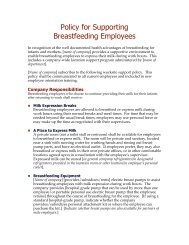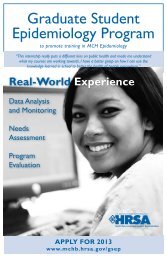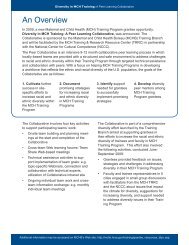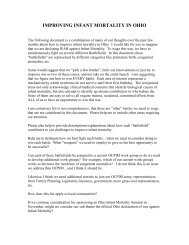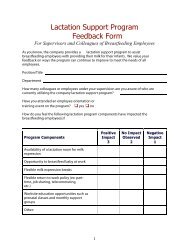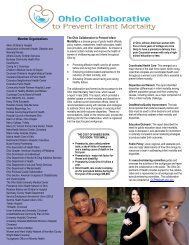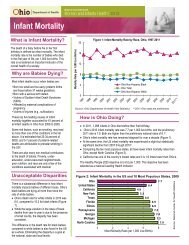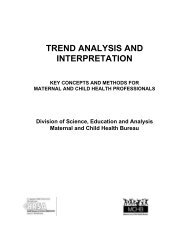MCHB Strategic Plan - Maternal and Child Health Bureau - HRSA
MCHB Strategic Plan - Maternal and Child Health Bureau - HRSA
MCHB Strategic Plan - Maternal and Child Health Bureau - HRSA
Create successful ePaper yourself
Turn your PDF publications into a flip-book with our unique Google optimized e-Paper software.
MATERNAL AND CHILD HEALTH BUREAUSTRATEGIC PLAN: FY 2003 - 2007(Updated: December 2003)INTRODUCTIONThe document that follows is divided into four main sections:Part I:Part II:Overview of <strong>Maternal</strong> <strong>and</strong> <strong>Child</strong> <strong>Health</strong> <strong>Bureau</strong> – Mission Statement, History <strong>and</strong>Focus, MCH Partners, <strong>and</strong> Organizational Structure.The <strong>Plan</strong> – Goals, Key Strategies, Performance Measures <strong>and</strong> Annual Priorities.Part III: Conceptual Framework for the <strong>Plan</strong> – The <strong>MCHB</strong> Vision, <strong>MCHB</strong> GuidingPrinciples, MCH <strong>Health</strong> Services Pyramid, <strong>and</strong> Key Documents/Linkages.Part IV:The <strong>Plan</strong>ning Cycle – Needs Assessment; Development of Goals, Key Strategies<strong>and</strong> Annual Priorities; Program <strong>and</strong> Resource Allocation; <strong>and</strong> PerformanceMeasures <strong>and</strong> Evaluation.Part I: OVERVIEW OF MATERNAL AND CHILD HEALTH BUREAUMission StatementThe mission of the <strong>Maternal</strong> <strong>and</strong> <strong>Child</strong> <strong>Health</strong> <strong>Bureau</strong> (<strong>MCHB</strong>) is to provide nationalleadership, in partnership with key stakeholders, to improve the physical <strong>and</strong> mental health,safety <strong>and</strong> well-being of the maternal <strong>and</strong> child health (MCH) population which includes all ofthe nation’s women, infants, children, adolescents, <strong>and</strong> their families, including fathers <strong>and</strong>children with special health care needs.<strong>MCHB</strong> History <strong>and</strong> FocusWith roots going back nearly a century, the Federal <strong>Maternal</strong> <strong>and</strong> <strong>Child</strong> <strong>Health</strong> <strong>Bureau</strong> (<strong>MCHB</strong>) ofthe <strong>Health</strong> Resources <strong>and</strong> Services Administration (<strong>HRSA</strong>), Department of <strong>Health</strong> <strong>and</strong> HumanServices (DHHS) has the primary responsibility for promoting <strong>and</strong> improving the health of ournation’s women, children <strong>and</strong> families. This Federal commitment to addressing maternal <strong>and</strong>child health (MCH) can be traced first to the <strong>Child</strong>ren’s <strong>Bureau</strong> (established in 1912) <strong>and</strong> then toTitle V of the Social Security Act (enacted in 1935), which focuses on maternal <strong>and</strong> child health1
services. Today, <strong>MCHB</strong> administers a broad range of programs that address the needs of thenation’s MCH population 1 , the largest of which is Title V, the <strong>Maternal</strong> <strong>and</strong> <strong>Child</strong> <strong>Health</strong> ServicesBlock Grant, which includes State Formula Block Grants, Special Projects of Regional <strong>and</strong>National Significance (SPRANS) grants <strong>and</strong> Community Integrated Service Systems (CISS)grants.Working with a wide range of public <strong>and</strong> private sector partners, <strong>MCHB</strong> provides both aframework <strong>and</strong> a focal point for MCH efforts at the national, State <strong>and</strong> local levels. Through theMCH Block Grant, the <strong>Bureau</strong> provides funds to every State <strong>and</strong> territory to support a statewideMCH program, including a program for children with special health care needs (CSHCN) 2 . The<strong>Bureau</strong> promotes <strong>and</strong> supports the development of family-centered, culturally/linguisticallycompetent, community-based systems of care nationwide for CSHCN, <strong>and</strong> the entire MCHpopulation. <strong>MCHB</strong> resources <strong>and</strong> programs are often directed to meet the particulardevelopmental or societal needs of one or more of the target MCH population groups. In addition,<strong>MCHB</strong> funds are used to train MCH professionals; conduct research to improve MCH status <strong>and</strong>services; develop st<strong>and</strong>ards for MCH services; <strong>and</strong> build MCH/public health capacity forassessment, planning <strong>and</strong> quality assurance. Finally, <strong>MCHB</strong> funds are used to develop <strong>and</strong>support systems <strong>and</strong> programs that address specific health <strong>and</strong> safety issues such as: abstinenceeducation, bioterrorism, emergency medical services for children, genetics, infant mortality, injuryprevention, nutrition, oral health, poison control, traumatic brain injury, universal newbornscreening <strong>and</strong> women’s health.MCH PartnersThe <strong>Maternal</strong> <strong>and</strong> <strong>Child</strong> <strong>Health</strong> <strong>Bureau</strong> works with a wide range of public <strong>and</strong> private sectorpartners, including States, communities, professional associations, academic institutions, theresearch community, faith-based organizations, other organizations <strong>and</strong> agencies, providers <strong>and</strong>families. <strong>Bureau</strong> grantees are included among its MCH partners.1 See Appendix A for a listing of current programs administered by <strong>MCHB</strong>.2 <strong>Child</strong>ren with special health care needs are those who have or are at increased risk for a chronicphysical, developmental, behavioral or emotional condition <strong>and</strong> who also require health <strong>and</strong> relatedservices of a type or amount beyond that required by children generally.2
Organizational StructureThe <strong>MCHB</strong> is directed by the <strong>HRSA</strong> Associate Administrator for <strong>Maternal</strong> <strong>and</strong> <strong>Child</strong> <strong>Health</strong>. Inaddition to the Office of the Associate Administrator, the <strong>Bureau</strong> includes the following offices<strong>and</strong> divisions 3 :Office of Operations ManagementOffice of Program DevelopmentOffice of Data <strong>and</strong> Information Management<strong>HRSA</strong> Office of Women’s <strong>Health</strong><strong>HRSA</strong> Office of Adolescent <strong>Health</strong><strong>HRSA</strong> Office of Adolescent <strong>Health</strong>Division of Perinatal Systems <strong>and</strong> Women’s <strong>Health</strong>Division of <strong>Child</strong>, Adolescent <strong>and</strong> Family <strong>Health</strong>Division of Services for <strong>Child</strong>ren with Special <strong>Health</strong> Care NeedsDivision of Research, Training <strong>and</strong> EducationDivision of State <strong>and</strong> Community <strong>Health</strong>3 See Appendix B for <strong>MCHB</strong> organizational chart.3
Part II:THE PLAN – GOALS, KEY STRATEGIES, PERFORMANCEMEASURES AND ANNUAL PRIORITIESGoals for FY 2003 - 2007In order to fulfill its mission, the <strong>Bureau</strong> has set the following five broad goals forFY 2003 - 2007:Goal 1:Goal 2:Goal 3:Goal 4:Goal 5:Provide National Leadership for <strong>Maternal</strong> <strong>and</strong> <strong>Child</strong> <strong>Health</strong>Promote an Environment that Supports <strong>Maternal</strong> <strong>and</strong> <strong>Child</strong> <strong>Health</strong>Eliminate <strong>Health</strong> Barriers <strong>and</strong> DisparitiesImprove the <strong>Health</strong> Infrastructure <strong>and</strong> Systems of CareAssure Quality of CareKey Strategies: FY 2003 - 2007The <strong>MCHB</strong> key strategies are the broad, cross-cutting approaches the <strong>Bureau</strong> uses in order toreach its five-year goals. Key strategies for FY 2003 - 2007 are listed below by goal:GoalGoal 1 – ProvideNational Leadership for<strong>Maternal</strong> <strong>and</strong> <strong>Child</strong><strong>Health</strong>Goal 2 – Promote anEnvironment thatSupports <strong>Maternal</strong> <strong>and</strong><strong>Child</strong> <strong>Health</strong>Key Strategies• Create a shared vision <strong>and</strong> goals for MCH.• Strengthen the MCH knowledge base <strong>and</strong> support scholarship withinthe MCH community.• Forge strong, collaborative, sustainable MCH partnerships bothwithin <strong>and</strong> beyond the health sector.• Promote family leadership in MCH service delivery, evaluation <strong>and</strong>program/policy development.• Provide both graduate level <strong>and</strong> continuing education training toassure interdisciplinary MCH public health leadership nationwide.• Using the best available evidence, develop <strong>and</strong> promote guidelines<strong>and</strong> practices to assure social, emotional <strong>and</strong> physical environmentthat supports the health <strong>and</strong> well-being of the MCH population.• Work with States <strong>and</strong> communities to plan <strong>and</strong> implement policies<strong>and</strong> programs to improve the social, emotional <strong>and</strong> physicalenvironment.4
GoalGoal 3 – Eliminate<strong>Health</strong> Barriers <strong>and</strong>DisparitiesGoal 4 – Improve the<strong>Health</strong> Infrastructure<strong>and</strong> Systems of CareGoal 5 – Assure Qualityof CareKey Strategies• Develop <strong>and</strong> promote health services <strong>and</strong> systems of care designedto eliminate disparities <strong>and</strong> barriers across the MCH population.• Train an MCH workforce that is culturally competent <strong>and</strong> reflects anincreasingly diverse population.• Build analytic capacity for assessment, planning, <strong>and</strong> evaluation.• Using the best available evidence, develop <strong>and</strong> promote guidelines<strong>and</strong> practices that improve services <strong>and</strong> systems of care.• Assist States <strong>and</strong> communities to plan <strong>and</strong> develop comprehensive,integrated health service systems.• Work with States <strong>and</strong> communities to assure that services <strong>and</strong>systems of care reach targeted populations.• Work with States <strong>and</strong> communities to address selected issues withintargeted populations.• Build analytic capacity to assess <strong>and</strong> assure quality of care.• Develop <strong>and</strong> promote health services <strong>and</strong> systems designed toimprove quality of care.• Develop <strong>and</strong> promote health services <strong>and</strong> systems that assureappropriate follow-up services.Performance Measures: FY 2003 - 2007In keeping with its commitment to accountability <strong>and</strong> in accordance with the GovernmentPerformance Results Act (GPRA), the <strong>Bureau</strong> has developed performance measures as one meansof tracking progress in meeting its five-year goals. These are not the only measures of the<strong>Bureau</strong>’s success in designing <strong>and</strong> implementing effective strategies to improve maternal <strong>and</strong> childhealth; however, they do represent an important component of the <strong>Bureau</strong>’s overall selfevaluation.See below for the <strong>MCHB</strong> performance measures for FY 2003 - 2007, listed withrelated goals, strategies, <strong>and</strong> targets through FY 2007. 44 For a fully annotated set of performance measures – including objectives, measures, target, definitions,<strong>Health</strong>y People 2010 objective s (where applicable), data sources <strong>and</strong> significance – see the <strong>MCHB</strong>Website: www.mchb.hrsa.gov. .5
Goal 1: Provide National Leadership for <strong>Maternal</strong> <strong>and</strong> <strong>Child</strong> <strong>Health</strong><strong>MCHB</strong> PERFORMANCE MEASURES: FY 2003 – 2007Key StrategiesA. Create a shared vision <strong>and</strong>goals for MCH.B. Strengthen the MCHknowledge base <strong>and</strong> supportscholarship within the MCHcommunity.C. Forge strong, collaborative,sustainable MCH partnershipsboth within <strong>and</strong> beyond thehealth sector.D. Promote family leadershipin MCH service delivery,evaluation <strong>and</strong> program/policydevelopment.E. Provide both graduate level<strong>and</strong> continuing educationtraining to assureinterdisciplinary MCH publichealth leadership nationwide.*New Indicator, no baselinePerformance Measures• The percent of <strong>MCHB</strong> supported programs that are satisfied with the leadership of <strong>and</strong> services receivedfrom <strong>MCHB</strong>. 2002 Baseline: 73%. 2007 Target: 80%.• The percent of <strong>MCHB</strong> customers (clients) of <strong>MCHB</strong> programs that are satisfied with services receivedfrom <strong>MCHB</strong> supported projects. 2007 Target: 80%.*• The percent of completed <strong>MCHB</strong> supported projects publishing findings in peer-reviewed journals. 2007Target: 5%.*• The number of publications, including peer-reviewed manuscripts, authored or co-authored by <strong>MCHB</strong>staff. 2002 Baseline: 4. 2007 Target: 8 per year.• The percent of <strong>MCHB</strong> supported projects that are sustained in the community after the federal grantproject period is completed. 2007 Target: 50%.*• The degree to which <strong>MCHB</strong> supported programs ensure family participation in program <strong>and</strong> policyactivities. 2007 Target: Average score of 12 out of 18 total.*• The degree to which the State ensures family participation in program <strong>and</strong> policy activities in the StateCSHCN program. 2001 Baseline: Average score of 12.6 out of 18 total. 2007 Target: Average score of 15out of 18 total.• The percent of graduates of <strong>MCHB</strong> long-term training programs that demonstrate field leadership aftergraduation. 2007 Target: 70%.*6
Goal 2: Promote an Environment that Supports <strong>Maternal</strong> <strong>and</strong> <strong>Child</strong> <strong>Health</strong>.Key StrategiesA. Using the best availableevidence, develop <strong>and</strong> promoteguidelines <strong>and</strong> practices toassure social, emotional <strong>and</strong>physical environment thatsupports the health <strong>and</strong> wellbeingof the MCH population.B. Work with States <strong>and</strong>communities to plan <strong>and</strong>implement policies <strong>and</strong>programs to improve the social,emotional <strong>and</strong> physicalenvironment.Performance Measures• The rate of deaths to children aged 14 years <strong>and</strong> younger caused by motor vehicle crashes per 100,000children. 2001 Baseline: 3.87/100,000. 2007 Target: 3.0/100,000.• The rate (per 100,000) of suicide deaths among youths aged 15 through 19. 2001 Baseline: 7.5/100,0002007: Target: 7.5/100,000.• The degree to which States promote <strong>and</strong> protect the health <strong>and</strong> safety of children age 1 through 6 in childcare settings. 2007 Target: Average score of 10 out of 15 total.*• The degree to which States have implemented injury <strong>and</strong> violence prevention activities. 2007 Target:Average score of 25 out of 36 total.**New Indicator, no baseline7
Goal 3: Eliminate <strong>Health</strong> Barriers <strong>and</strong> DisparitiesKey StrategiesA. Develop <strong>and</strong> promote healthservices <strong>and</strong> systems of caredesigned to eliminatedisparities <strong>and</strong> barriers acrossthe MCH population.B. Train an MCH workforcethat is culturally competent <strong>and</strong>reflects an increasingly diversepopulation.Performance Measures• The degree to which <strong>MCHB</strong> supported programs have incorporated cultural competence elements intotheir policies, guidelines, contracts <strong>and</strong> training. 2007 Target: Average score of 55 out of 69 total.*• The percent of children under age 21 enrolled in Medicaid for at least 6 months continuously during theyear who receive any preventive or treatment dental service. 2000 Baseline: 30%. 2007 Target: 50%.• The degree to which the State <strong>Child</strong>ren with Special <strong>Health</strong> Care Needs (CSHCN) Program provides orpays for specialty <strong>and</strong> sub-specialty services, including care coordination, not otherwise accessible oraffordable to its clients. 2001 Baseline: Average score 8.19 out of 23 total. 2007 Target: Average score of12 out of 23 total.• Percent of <strong>Child</strong>ren with Special <strong>Health</strong> Care Needs (CSHCN) in the State CSHCN program with a sourceof insurance for primary <strong>and</strong> specialty care. 2001 Baseline: 88.2%. 2007 Target: 90%.• Percent of children without health insurance. 2001 Baseline: 13.06%. 2007 Target: 10%.• Percent of potentially Medicaid-eligible children who have received a service paid by the MedicaidProgram. 2001 Baseline: 77.34%. 2007 Target: 85%.• The degree to which grantees assist families of children with special health needs to partner in decisionmaking <strong>and</strong> be satisfied with services they receive. 2007 Target: Average score of 100 out of 125 total.*• The degree to which <strong>MCHB</strong> long-term training grantees include cultural competency in theircurricula/training. 2007 Target: Average score of 21 out of 27 total.*• The percent of participants in <strong>MCHB</strong> long-term training programs who are from under-represented groups.2007 Target: 20%. **New Indicator, no baseline8
Goal 4: Improve the <strong>Health</strong> Infrastructure <strong>and</strong> Systems of CareKey StrategiesA. Build analytic capacity forassessment, planning, <strong>and</strong>evaluation.B. Using the best availableevidence, develop <strong>and</strong> promoteguidelines <strong>and</strong> practices thatimprove services <strong>and</strong> systems ofcare.C. Assist States <strong>and</strong>communities to plan <strong>and</strong>develop comprehensive,integrated health servicesystems.*New Indicator, no baselinePerformance Measures• The degree to which States electronically link vital statistics data sets, Medicaid, <strong>and</strong> other healthinformation systems data sets. 2007 Target: Average score of 19 out of 32 total.*• The degree to which grantees electronically link vital statistics data sets, Medicaid, <strong>and</strong> other healthinformation systems data sets. 2007 Target: Average score of 58 out of 72 total.*• The degree to which <strong>MCHB</strong> supported programs facilitate health providers’ screening of womenparticipants for risk factors. 2007 Target: Average score of 47 out of 72 total.*• The percent of States with pediatric guidelines for acute care facilities to provide emergency <strong>and</strong> criticalcare. 2001 Baseline: 73%. 2007 Target: 80%.• The degree to which a State system for nutrition services has been established for MCH populations. 2007Target: Average score of 19 out of 24 total.*• The number of States that include in their oral health plans at least 5 of the 10 essential elements of theguidelines included in ASTDD’s “Building Infrastructure & Capacity in State <strong>and</strong> Territorial Oral <strong>Health</strong>Programs.” 2000 Baseline: 20 State <strong>and</strong> Territories. 2007 Target: 37 States <strong>and</strong> Territories.• The degree to which States <strong>and</strong> Communities have implemented comprehensive systems for women’shealth services. 2007 Target: Average score of 22 out of 28 total.*• The degree to which grantees have assisted States in organizing community-based service systems so thatfamilies of children with special health care needs can use them easily. 2007 Target: Average score of 9out of 21 total.*• The degree to which States have developed a comprehensive adolescent health strategic planning process.2007 Target: Average score of 50 out of a combined total score of 63.*• The degree to which State agencies work collaboratively to develop a <strong>Plan</strong> for building early childhoodservice systems. 2007 Target: Average score of 19 out of 24 total.*9
Goal 4: Improve the <strong>Health</strong> Infrastructure <strong>and</strong> Systems of CareKey StrategiesD. Work with States <strong>and</strong>communities to assure thatservices <strong>and</strong> systems of carereach targeted populations.E. Work with States <strong>and</strong>communities to addressselected issues within targetedpopulations*New Indicator, no baselinePerformance Measures• The percent of pregnant participants of <strong>MCHB</strong> supported programs who have a prenatal care visit in thefirst trimester of pregnancy. 2007 Target: 80%.• The degree to which grantees have assisted States in increasing the percentage of youth with special healthcare needs who have received services necessary to make transitions to all aspects of adult life, includingadult health care, work <strong>and</strong> independence. 2007 Target: Average score of 7 out of 9 total.*• The percent of State SSI beneficiaries less than 16 years old receiving rehabilitative services from the State<strong>Child</strong>ren with Special <strong>Health</strong> Care Needs (CSHCN) Program. 2001 Baseline: 24.68%. 2007 Target: 50%.• Percent of newborns in the State with at least one screening for each of the following: PKU,hypothyroidism, galactosemia, hemoglobinopathies [(e.g. the sickle cell diseases) (combined)] 2001Baseline: 99.27%. 2007 Target: 99.5%.• Percent of children through age 2 who have completed immunizations for Measles, Mumps, Rubella, Polio,Diphtheria, Tetanus, Pertussis, Haemophilus Influenza, Hepatitis B. 2001 Baseline: 76.84% . 2007 Target:85%.• Percent of third grade children who have received protective sealants on at least one permanent molartooth. 2001 Baseline: 25.12%. 2007 Target: 35%.• Percentage of mothers who breastfeed their infants at hospital discharge. 2001 Baseline: 59.32%. 2007Target: 75%.• Percentage of newborns who have been screened for hearing impairment before hospital discharge. 2001Baseline: 63.54%. 2007 Target: 80%.• Percent of very low birth weight infants delivered at facilities for high-risk deliveries <strong>and</strong> neonates. 2001Baseline: 73.83%. 2007 Target: 85%.• Percent of infants born to pregnant women receiving prenatal care beginning in the first trimester. 2001Baseline: 81.34%. 2007 Target: 85%.• The rate of birth (per 1,000) for teenagers aged 15 through 17 years. 2001 Baseline: 27.28/100,000. 2007Target: 25/1,000• Percent of very low birth weight live births. 2001 Baseline: 1.46%. 2007 Target: 1.35%.10
Goal 5: Assure Quality of CareKey StrategiesPerformance MeasuresA. Build analytic capacity toassess <strong>and</strong> assure quality of• The percent of States that have MCH staff who perform specific epidemiological activities <strong>and</strong> otherMCH evaluations <strong>and</strong> analyses. 2002 Baseline: 80%. 2007 Target: 90%.care.• The degree to which States <strong>and</strong> communities use “morbidity/mortality” review processes in MCH needsassessment, quality improvement, <strong>and</strong>/or data capacity building. 2007 Target: Average score of 3 out of 9B. Develop <strong>and</strong> promote healthservices <strong>and</strong> systems designed toimprove quality of care.C. Develop <strong>and</strong> promote healthservices <strong>and</strong> systems that assureappropriate follow-up services.*New Indicator, no baselinetotal.*• The percent of children with special health care needs age 0 to 18 whose families have adequate private<strong>and</strong>/or public insurance to pay for needed services. 2007 Target: Estimated 80%.• The degree to which grantees have assisted States in increasing the percent of children with special healthcare needs, age 0 to 18, whose families have adequate private <strong>and</strong>/or public insurance to pay for neededservices. 2007 Target: Average score of 14 out of 18 total.*• The percent of all children from birth to age 18 participating in <strong>MCHB</strong> supported programs who have amedical home. 2007 Target: 80% .*• The percent of children with special health care needs age 0 through 18 who receive coordinated, ongoing,comprehensive care within a medical home. 2007 Target: 80%• The degree to which grantees have assisted States in increasing the percent of children with special healthcare needs age 0 through 18 who receive coordinated, ongoing, comprehensive care within a medicalhome. 2007 Target: Average score of 12 out of 15 total*• The percent of women participating in <strong>MCHB</strong> supported programs who have an ongoing source ofprimary <strong>and</strong> preventive care services for women. 2007 Target: 80%*• The percent of <strong>Child</strong>ren with Special <strong>Health</strong> Care Needs (CSHCN) in the State who have a“medical/health home”. 2001 Baseline: 56.37% 2007 Target: 75%.• The number of women participating in <strong>MCHB</strong> supported programs requiring a referral, who receive acompleted referral. 2007 Target: 80%.• The degree to which grantees have assisted States in increasing the percentage of children who arescreened early <strong>and</strong> continuously for special health care needs <strong>and</strong> linked to medical homes, appropriatefollow-up, <strong>and</strong> early interventions. 2007 Target: Average score of 14 out of 18 total.*• The percent of program participants who successfully complete or remain enrolled in an <strong>MCHB</strong> supportedabstinence-only program. 2007 Target: 80%.*11
PART III:CONCEPTUAL FRAMEWORK FOR THE PLANThe <strong>MCHB</strong> Vision<strong>MCHB</strong> believes in <strong>and</strong> strives to shape a future America in which:• All children are wanted, nurtured <strong>and</strong> provided the assistance they need to mature intohealthy, productive adults.• Women’s health, safety <strong>and</strong> well-being throughout the life cycle are a priority.• Families <strong>and</strong> individuals, young <strong>and</strong> old alike, are engaged in health promoting activities thatare supported at the community level.• The right to achieve one’s full potential is universally assured through attention to thecomprehensive physical, biological, intellectual, emotional <strong>and</strong> social needs of the MCHpopulation.• There is equal access for all to comprehensive, quality health care provided in a supportive,culturally competent environment, which is family-centered <strong>and</strong> community-based.• All women <strong>and</strong> children, especially children with special health care needs, are linked to acomprehensive, community-based service system through a medical home.• <strong>Health</strong> disparities by racial, ethnic, geographic area <strong>and</strong> economic status have beeneliminated.• MCH/public health agencies exemplify the highest st<strong>and</strong>ards of excellence: building systemsof care grounded in the best available knowledge, developing essential public healthcapacities <strong>and</strong> competencies in the service of the MCH population; employing a highlyqualified, diverse workforce; <strong>and</strong> providing a respectful <strong>and</strong> supportive work environment.• Society recognizes <strong>and</strong> fully supports the important role that public health plays in promotingthe health of the MCH population, including building, strengthening <strong>and</strong> assuring MCHhealth services <strong>and</strong> infrastructure at all levels.12
<strong>MCHB</strong> Guiding PrinciplesThe following principles guide the work of the <strong>Bureau</strong> <strong>and</strong> the development <strong>and</strong> implementationof its strategic plan:Principles for <strong>MCHB</strong> Leadership Roles <strong>and</strong> Responsibilities• Leadership, performance <strong>and</strong> accountability form the basis for the <strong>Bureau</strong>’s approach todoing business.• Effective leadership requires collaborative partnership as well as excellent communicationamong key stakeholders.• In accordance with the Government Performance <strong>and</strong> Results Act (GPRA), <strong>and</strong> as part of itsnational leadership role, the <strong>Bureau</strong> maintains high expectations for performance <strong>and</strong> holdsitself, its grantees <strong>and</strong> other partners accountable for the use of <strong>MCHB</strong> resources.• Evaluation is an essential tool for program management: evaluations provide the informationneeded to assess impact, strengthen programs <strong>and</strong> make sound decisions about futureallocation of resources.• Promoting <strong>and</strong> maintaining a respectful, supportive work environment is key to successfulperformance.Principles for the Organization of MCH Systems <strong>and</strong> Services• In order to assure the health of the nation, it is necessary to build <strong>and</strong> maintain a public healthinfrastructure <strong>and</strong> a highly competent public health workforce, with the capacity to monitor,assess <strong>and</strong> address changing health needs across the population in a timely <strong>and</strong> effectivemanner.• The health, safety <strong>and</strong> well-being of the MCH population is best assured when there is anMCH/family health focus within health systems <strong>and</strong> services.• Family <strong>and</strong> community participation <strong>and</strong> engagement are key to the development ofeffective, quality health systems <strong>and</strong> services.• Women, infants, children, adolescents <strong>and</strong> children with special health care needs eachpresent unique developmental or life cycle needs <strong>and</strong> opportunities that must be recognized<strong>and</strong> addressed by health systems <strong>and</strong> services.• <strong>Health</strong> systems <strong>and</strong> services should be sensitive to the unique gender, race, age <strong>and</strong> culturalcontexts of women, children <strong>and</strong> their families.13
• <strong>Health</strong> systems should include a full array of services including, among others, mental,nutritional <strong>and</strong> oral health services.• <strong>Health</strong> systems <strong>and</strong> services should be scientifically-based.• <strong>Health</strong> systems <strong>and</strong> services should work closely with partners both within <strong>and</strong> beyond thehealth sector, to assure that the broader environment in which children <strong>and</strong> families live <strong>and</strong>develop is supportive <strong>and</strong> nurturing.• <strong>Health</strong> systems <strong>and</strong> services can best reach <strong>and</strong> serve our increasingly diverse MCHpopulation by providing community-based, culturally competent care delivered by a highlyqualified, interdisciplinary <strong>and</strong> culturally diverse workforce that is sensitive to those withspecial needs.• <strong>Health</strong> systems <strong>and</strong> services need to address societal <strong>and</strong> community risk factors in additionto individual factors affecting health.14
MCH <strong>Health</strong> Services Pyramid<strong>MCHB</strong> uses the construct of a pyramid to describe the four levels of core public health servicesfor the MCH population. Starting at the base, these are: (1) infrastructure building services, (2)population-based services, (3) enabling services, <strong>and</strong> (4) direct health care (gap-filling) services.Infrastructure-building <strong>and</strong> population-based services provide the broad foundation upon whichenabling <strong>and</strong> direct care services rest. (See Figure below) The MCH health services pyramidprovides a useful framework for underst<strong>and</strong>ing programmatic directions <strong>and</strong> resource allocationby the <strong>Bureau</strong> <strong>and</strong> its partners as they work collaboratively to carry out the <strong>MCHB</strong> mission <strong>and</strong>accomplish the <strong>MCHB</strong> goals.CORE PUBLIC HEALTH SERVICESDELIVERED BY MCH AGENCIESDIRECTHEALTH CARESERVICES:(GAP FILLING)Examples:Basic <strong>Health</strong> Services,<strong>and</strong> <strong>Health</strong> Services for CSHCNENABLING SERVICES:Examples:Transportation, Translation, Outreach,Respite Care, <strong>Health</strong> Education, FamilySupport Services, Purchase of <strong>Health</strong> Insurance,Case Management, Coordination with Medicaid,WIC, <strong>and</strong> EducationPOPULATION-BASED SERVICES:Examples:Newborn Screening, Lead Screening, Immunization,Sudden Infant Death Syndrome Counseling, Oral <strong>Health</strong>,Injury Prevention, Nutrition<strong>and</strong> Outreach/Public EducationINFRASTRUCTURE BUILDING SERVICES:Examples:Needs Assessment, Evaluation, <strong>Plan</strong>ning, Policy Development,Coordination, Quality Assurance, St<strong>and</strong>ards Development, Monitoring,Training, Applied Research, Systems of Care, <strong>and</strong> Information Systems15
Key Documents/LinkagesThe plan is informed by <strong>and</strong> linked to a wide range of documents. Among the key documentsthat are essential to the plan’s development are the following:<strong>Health</strong>y People 2010 ObjectivesTen Year Action <strong>Plan</strong> for CSHCN <strong>and</strong> their FamiliesDHHS <strong>Strategic</strong> <strong>Plan</strong><strong>HRSA</strong> <strong>Strategic</strong> <strong>Plan</strong><strong>MCHB</strong> Division <strong>and</strong> Office <strong>Strategic</strong> <strong>Plan</strong>sState Title V Performance MeasuresDraft Performance Measures for <strong>MCHB</strong> Discretionary GrantsTitle V Information System (www.mchdata.net)MCH Partners’ <strong>Strategic</strong> <strong>Plan</strong>s16
PART IV:THE PLANNING CYCLEWhile <strong>MCHB</strong> develops a new <strong>Strategic</strong> <strong>Plan</strong> once every five years, the planning cycle is ongoing<strong>and</strong> iterative <strong>and</strong> includes the following components:Needs AssessmentThe <strong>Bureau</strong> reviews available data, documents, <strong>and</strong> program evaluations; identifies national,State <strong>and</strong> local MCH issues <strong>and</strong> concerns; <strong>and</strong> consults with MCH partners on a regular basis toassess assets <strong>and</strong> needs related to the MCH population <strong>and</strong> to MCH/public health infrastructure<strong>and</strong> service systems. In addition, every five years in preparation for developing a new plan, the<strong>Bureau</strong> explicitly solicits feedback on strategic planning directions from its many MCH partners.Development of Goals, Key Strategies <strong>and</strong> Annual PrioritiesEvery five years, the <strong>Bureau</strong> reviews <strong>and</strong> revises its broad goals. The new goals are based onfindings from the <strong>Bureau</strong>’s needs assessments <strong>and</strong> environmental scans, <strong>and</strong> are consistent withthe overall direction <strong>and</strong> goals of <strong>HRSA</strong>, <strong>and</strong> DHHS. The key strategies describe the broad,cross-cutting approaches by which the <strong>Bureau</strong> will reach its goals. In order to address emergingissues <strong>and</strong> to highlight priority activities <strong>and</strong> issues for each year, the <strong>Bureau</strong> also develops ashort list of annual priorities for its work. Together, the goals, key strategies <strong>and</strong> annualpriorities inform <strong>MCHB</strong>’s resource allocation.Program <strong>and</strong> Resource Allocation<strong>Bureau</strong> goals, key strategies <strong>and</strong> annual priorities are operationalized by <strong>MCHB</strong>’s divisions <strong>and</strong>offices, which work with the Associate Administrator to determine specific programmaticpriorities, allocate resources <strong>and</strong> oversee implementation of programs <strong>and</strong> policies. The<strong>Bureau</strong>’s policy <strong>and</strong> program priorities encompass a wide range of health conditions <strong>and</strong> issues:some are specific to an age or population group, while others cut across populations. Thepriorities are implemented through the <strong>Bureau</strong>’s State Block Grants, discretionary grantprograms <strong>and</strong> special initiatives.17
Performance Measurement <strong>and</strong> Evaluation<strong>MCHB</strong> uses performance measurement <strong>and</strong> program evaluation to assess progress in attaininggoals, implementing strategies <strong>and</strong> addressing priorities. <strong>Bureau</strong> performance measures arekeyed to the <strong>MCHB</strong> strategic goals. Each <strong>Bureau</strong> performance measure has six majorcomponents: five-year objectives, measures to be used, definition of the measures, relevant<strong>Health</strong>y People 2010 objectives (where applicable), data source <strong>and</strong> significance. The <strong>MCHB</strong>performance measures are a “work in progress” – reflecting various developmental stages inmeasurement <strong>and</strong> availability of data. 5 <strong>Bureau</strong> evaluation activities focus on specificprogrammatic priorities <strong>and</strong> are guided by an internal <strong>Bureau</strong> Evaluation CoordinatingCommittee. Evaluation is critical to <strong>MCHB</strong> policy <strong>and</strong> program development, programmanagement <strong>and</strong> funding. Findings from program evaluations <strong>and</strong> performance measurementbecome part of the ongoing needs assessment activities of the <strong>Bureau</strong>. Thus, the planning cyclebegins again.5 See Appendix D for a description of the criteria used in selecting <strong>MCHB</strong> performance measures.18
APPENDIX ACURRENT PROGRAMS ADMINISTERED BY <strong>MCHB</strong>Over the years, the Federal commitment to maternal <strong>and</strong> child health has broadened to meet newneeds, so that the <strong>Maternal</strong> <strong>and</strong> <strong>Child</strong> <strong>Health</strong> <strong>Bureau</strong> now administers ten major programs fundedlargely by Congress. In FY2002, these programs had a total Federal budget of more than $1.1billion, including the following:(1) <strong>Maternal</strong> <strong>and</strong> <strong>Child</strong> <strong>Health</strong> Services Block Grant – Title V, Social Security Act(includes SPRANS, CISS <strong>and</strong> State Formula Grants);(2) <strong>Health</strong>y Start Initiative – Section 330H, Public <strong>Health</strong> Service Act;(3) Universal Newborn Hearing Screening – Section 399M, Public <strong>Health</strong> Service Act;(4) Abstinence Education Program – Section 510, Title V, Social Security Act;(5) Community-Based Abstinence Education Program – Section 501(a)(2), Title V,Social Security Act, <strong>and</strong> the Appropriations Act for the Departments of Labor, <strong>Health</strong><strong>and</strong> Human Services, Education <strong>and</strong> Related Agencies;(6) Traumatic Brain Injury – Section 1252, Public <strong>Health</strong> Service Act;(7) Emergency Medical Services for <strong>Child</strong>ren Program – Section 1910, Public <strong>Health</strong>Service Act;(8) Poison Control Centers Program – Poison Control Center Enhancement <strong>and</strong>Awareness Act;(9) Trauma/Emergency Medical Services – Section 1232, Public <strong>Health</strong> Service Act;<strong>and</strong>(10) Hospital Preparedness (Bioterrorism) – Section 319, Public <strong>Health</strong> Service Act.19
APPENDIX B<strong>MCHB</strong> ORGANIZATIONAL CHART20
<strong>MCHB</strong> ORGANIZATIONAL CHART DESCRIPTIONOrganization Chart for the <strong>Maternal</strong> <strong>and</strong> <strong>Child</strong> <strong>Health</strong> <strong>Bureau</strong>, in the <strong>Health</strong> Resources <strong>and</strong>Services Administration, an agency of the U.S. Department of <strong>Health</strong> <strong>and</strong> Human ServicesOffice of the Associate AdministratorAssociate AdministratorPeter C. van Dyck, M.D., M.P.H.Deputy Associate AdministratorSteven Pelovitz. J.D.4 Offices <strong>and</strong> 5 Divisions report directly to the Office of the Associate Administrator:• <strong>HRSA</strong>’s Office of Women’s <strong>Health</strong>Acting DirectorSabrina Matoff, M.A.• Office of Operations <strong>and</strong> ManagementDirectorMichael A Mucci, Jr., M.B.A.• Office of Data <strong>and</strong> Information ManagementDirectorMichael Kogan, Ph.D.• Office of Program DevelopmentActing DirectorJack Tenenbaum• Division of Services for <strong>Child</strong>ren with Special <strong>Health</strong> NeedsDirectorMerle G. McPherson, M.D., M.P.H.Deputy DirectorVacant• Division of <strong>Child</strong>, Adolescent, <strong>and</strong> Family <strong>Health</strong>DirectorDavid E. Heppel, M.D.Deputy DirectorPete Conway• Division of Research, Training, <strong>and</strong> EducationDirectorM. Ann Drum, D.D.S., M.P.H.Deputy DirectorChris DeGraw, M.D., M.P.H.• Division of Perinatal Systems & Women’s <strong>Health</strong>21
Acting DirectorMaribeth Badura, R.N., M.S.N.Acting Deputy DirectorArt Knudson• Division of State <strong>and</strong> Community <strong>Health</strong>DirectorCassie Lauver, A.C.S.W.Deputy DirectorJeffery Koshel, M.A.2 Branches report directly to the Office of Operations <strong>and</strong> Management:• Financial Management BranchChiefScott Macdonald• Management Policy <strong>and</strong> Services BranchChiefG. Conrad Zink2 Branches report directly to the Division of Services for <strong>Child</strong>ren with Special <strong>Health</strong> Needs:• Integrated Services BranchChiefBonnie B. Strickl<strong>and</strong>, Ph.D.• Genetic Services BranchChiefMichele A. Puryear, M.D., Ph.D.3 Branches report directly to the Division of <strong>Child</strong>, Adolescent, <strong>and</strong> Family <strong>Health</strong>:• Infant & <strong>Child</strong> <strong>Health</strong> BranchChiefPhyllis E. Stubbs, M.D.• Adolescent <strong>Health</strong> BranchChiefTrina Anglin, M.D., Ph.D.• Injury <strong>and</strong> Emergency Medical Services BranchChiefVacant2 Branches report directly to the Division of Research, Training, <strong>and</strong> Education:• Research Branch22
ChiefVacant• Training BranchChiefLaura Kavanagh, M.P.P.2 Branches report directly to the Division of Perinatal Systems & Women’s <strong>Health</strong>:• <strong>Health</strong>y Start BranchChiefMaribeth Badura, R.N., M.S.N.• Perinatal & Women’s <strong>Health</strong> BranchChiefEllen Hutchins, Sc.D.1 Branch report directly to the Division of State <strong>and</strong> Community <strong>Health</strong>:• State <strong>and</strong> Community Partnership BranchChiefVacant23
APPENDIX CSCHEMATIC OF <strong>MCHB</strong> PLANNING CYCLE24
SCHEMATIC OF <strong>MCHB</strong> PLANNING CYCLE DESCRIPTIONThe <strong>MCHB</strong> planning cycle includes the following five components:1. <strong>MCHB</strong> Needs Assessment <strong>Health</strong> Status IndicatorsThe <strong>MCHB</strong> needs assessment <strong>and</strong> health status indicators are developed through statenational indicators, <strong>Health</strong>y People 2010 goals, legislative priorities, <strong>and</strong> partnershipinput.2. <strong>MCHB</strong> Priorities <strong>and</strong> GoalsThe <strong>MCHB</strong> Priorities <strong>and</strong> Goals include 1) decrease disparities; 2) increase quality; <strong>and</strong>3) improve infrastructure.3. <strong>MCHB</strong> Program <strong>and</strong> Resource AllocationThe <strong>MCHB</strong> Program <strong>and</strong> resource allocation are operationalized by the <strong>MCHB</strong> Pyramid.The pyramid consists of four levels of service <strong>and</strong> funding that build upon each other <strong>and</strong>provide comprehensive coverage. The collective effort of all States, in all levels of thepyramid, contributes to the national health of mothers <strong>and</strong> children.4. <strong>MCHB</strong> Performance Measures<strong>MCHB</strong> uses performance measurement <strong>and</strong> program evaluation to assess progress inattaining goals, implementing strategies <strong>and</strong> addressing priorities. The five areasmeasured are: 1) State Block Grant; 2) Special Projects of Regional <strong>and</strong> NationalSignificance (SPRANS); 3) <strong>Health</strong>y Start; 4) Emergency Services for <strong>Child</strong>ren; 5)Traumatic Brain Injury5. <strong>MCHB</strong> Outcome MeasuresThe <strong>MCHB</strong> outcome measures are the following: 1) perinatal mortality; 2) infantmortality; 3) neonatal mortality; 4) postneonatal mortality; 5) child mortality; <strong>and</strong> 6)infant death disparity.Performance Measurement <strong>and</strong> Evaluation<strong>MCHB</strong> uses performance measurement <strong>and</strong> program evaluation to assess progress in attaininggoals, implementing strategies <strong>and</strong> addressing priorities. <strong>Bureau</strong> performance measures arekeyed to the <strong>MCHB</strong> strategic goals. Each <strong>Bureau</strong> performance measure has six majorcomponents: five-year objectives, measures to be used, definition of the measures, relevant<strong>Health</strong>y People 2010 objectives (where applicable), data source <strong>and</strong> significance. The <strong>MCHB</strong>performance measures are a “work in progress” – reflecting various developmental stages inmeasurement <strong>and</strong> availability of data. 5 <strong>Bureau</strong> evaluation activities focus on specificprogrammatic priorities <strong>and</strong> are guided by an internal <strong>Bureau</strong> Evaluation CoordinatingCommittee. Evaluation is critical to <strong>MCHB</strong> policy <strong>and</strong> program development, programmanagement <strong>and</strong> funding. Findings from program evaluations <strong>and</strong> performance measurementbecome part of the ongoing needs assessment activities of the <strong>Bureau</strong>. Thus, the planning cyclebegins again.25
APPENDIX DSELECTION CRITERIA FOR <strong>MCHB</strong> PERFORMANCE MEASURESThe <strong>Bureau</strong> recognizes that performance measures have some inherent limitations: (1) they mayoften highlight the priorities that best lend themselves to direct measurement; (2) some are still inthe developmental stage, particularly with regard to complex, community-based interventions;<strong>and</strong> (3) the full impact of <strong>MCHB</strong> efforts can never be captured by a single set of performancemeasures <strong>and</strong> related indicators.With the above caveats in mind, the <strong>Bureau</strong> has used the following criteria in selectingperformance measures:• The measure should be relevant to major <strong>MCHB</strong> priorities, activities, programs <strong>and</strong>dollars.• The measure should be important <strong>and</strong> underst<strong>and</strong>able to MCH partners, policymakers <strong>and</strong> the public.• Data for the measure should generally be available.• There should be a logical link between the measure <strong>and</strong> the desired outcome.• It should be reasonable to expect measurable change in the indicator within five yearsor less.• Consideration should be given to the magnitude of the problem <strong>and</strong> the feasibility ofimproving performance related to the measure.• Special consideration should be given to measures that are prevention focused.26



